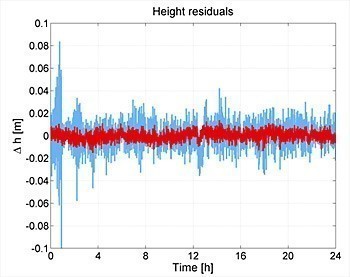Satellite Navigation using high precise Oscillators

| Led by: | Prof. Dr.-Ing. Steffen Schön |
| E-Mail: | schoen@ife.uni-hannover.de |
| Team: | Dipl.-Ing. Ulrich Weinbach |
| Year: | 2011 |
| Date: | 15-01-11 |
| Funding: | QUEST |
| Is Finished: | yes |
Within the framework of the Cluster of Excellence (QUEST), the Institute of Geodesy has been working since April 2008 on investigations into the application of high-precision oscillators in satellite navigation. This work is related to the development of novel optical atomic clocks by other groups of the Cluster of Excellence. In contrast to conventional atomic clocks, which are based on transition frequencies in the microwave range, optical clocks work with frequencies in the visible or ultraviolet light range. It is expected that by using the higher optical frequencies, the stability of the best currently available microwave atomic clocks (hydrogen maser) can be improved by a factor of 100.
High-precision clocks on board the GNSS satellites are a basic requirement for positioning in real time, as this is the only way to predict the signal transmission time in the system time scale with sufficient accuracy. However, the accuracy of the satellite clocks currently available is only sufficient for positioning utilising code observations and not for the much more precise carrier phase measurements. Besides, the clock error in the receiver must be taken into account for each observation epoch by an additional parameter in the position determination, which leads to a deterioration of the height component in GNSS positioning. The development of high-precision optical frequency standards opens up new possibilities for the parameterisation of satellite and receiver clocks, where the additional information about the frequency stability of the oscillators can be optimally used.Another success was the implementation and validation of a complete Precise Point Positioning (PPP) module in MATLAB. This provides the prerequisites for testing different approaches to clock modelling within the GNSS evaluation. Initial tests with both simulated and real data are already delivering very positive results. In particular, the height component in kinematic positioning can be significantly improved by suitable clock modelling.
Furthermore, the mathematical simulation of stochastic noise processes as they typically occur in atomic clocks was successfully tested. This makes it possible to simulate clocks that are not yet operationally available but whose frequency stability is already known.
For the coming year, clock modelling will be systematically further optimised, and the influence on the estimation of tropospheric parameters will be analysed.
It may also be possible to conduct new experiments using the high-precision fibre-optic connection between the PTB and the Institute of Quantum Optics (IQ) in Hanover. The first test measurements could already be carried out successfully last year.




